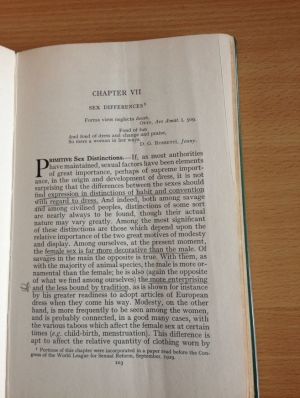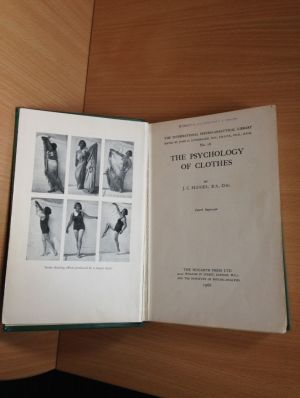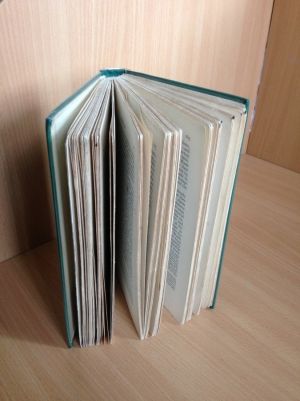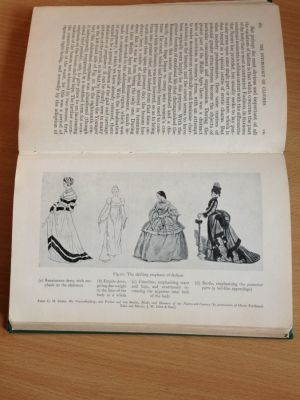This review is about a book called “The Psychology of Clothes” written by J.C. Flugel, published in 1966 London by the Hogarth Press LTD and the Institute of Psycho-analysis. The book contains 257 pages. It is hard-bound in dark grey covers and has black and white photographs, drawings and schematic images in addition to written text. There is an extensive bibliography that has been used by the author listed at the end.
While the main purpose of this book would be for psychology or fashion students (the former could use it to interpret behaviour or understand human characteristics, the latter to design clothes with a better understanding of history and fashion in relation to different cultural, religious, social aspects), art can also benefit from psychological insight. Artists could incorporate psychological aspects within artworks, for example, paint people dressed in a certain way.
I found this book in the library archive and I believe that it has been included in the Special Collection because: 1) it serves as a historical account of styles of dress and provides interpretation for them; 2) it shows the level of thinking and the most powerful psychological theories at the time when the book was written; 3) there is not so much literature available with regard to interpretation of choice of clothes; 4) it is published by the Hogarth Press.
With regard to the fourth point mentioned above, it has to be noted that Hogarth Press is a highly considered publisher. It was founded in 1917 and published works of key modernist writers as well as important translated works. It has made valuable contribution to modernism and British literary culture. (British Library, 2017)
The text in the book is written as an essay in the third person and the first person in plural but the historical descriptions and additions of scientific terms, theories and conclusions make this work close to a thesis. The language and proposed views in the book, despite its age are still very relevant and modern, as there are no topics that the author has tried to deliberately avoid.
There is much discussion about clothing items which relate to clothing fashion from previous centuries. The book describes historical and cultural aspects of clothes very well. The author compares clothes and accessories across different periods and what the same object can mean across differing cultures. He also extensively analyses the relation of clothes to gender and characteristics which are considered as male or female. Basically he addresses stereotypical views but without recognising those views as stereotypical.
Much of the analysis in the book is based on the writings and conclusions of Sigmund Freud who was an Austrian neurologist and commonly recognised as the father of psychoanalysis. (Isbister, 1985) Within this context a lot of clothing pieces and accessories are linked to symbolic understandings of male and female sexuality.
The text is written clearly and reads easily. Although the book is a mix between history and psychoanalytic theories one does not need to be specially trained in order to grasp the ideas and explanations. In some places the author uses what seem outdated phrases to try remain very polite to the reader. This approach doesn’t hinder the understanding and it adds charisma and charm to the book.
The same can be said about the font of the text and the images. The font is charmingly old-fashioned, the images show, for example, primitive tribal people, renaissance dresses, ancient sculptures, paintings of noblemen from previous centuries.
An element that makes the book something more than just a scientific account of history and psychology is little additions of citations in the beginning of each chapter. These citations are taken from novels, poems, sayings and other writings of different authors over different times.
Although the book has been written and published at a time when the topical views would not seem to be relevant in the present context, it is not quite like that. There are aspects in psychology which do not become outdated with the passing of time. In the introduction of the book it is mentioned that man is a social animal and accordingly he has to observe the bodies of his companions. But what we actually see is not the body of another person. We see the clothes. The clothes form the first impression of people. They immediately tell us something about the person’s sex, occupation, nationality, social standing and other aspects – and that allows us to modify our behaviour towards him or her. This idea holds true at any time and is a perfect reasoning why books like “The Psychology of Clothes” should be written, read and kept.
This book is also a very good material that can be used to analyse not only someone’s clothes and personality but also to put this text in comparison with similar texts written in recent years to find out if anything has changed and what new has been added in the psychology department in relation to clothes and how and why people choose them.
List of references (in alphabetical order)
British Library (2017) The Hogarth Press Available at: https://www.bl.uk/20th-century-literature/articles/the-hogarth-press (Accessed: 3 April 2017)
Isbister, J. N. (1985) Freud: An Introduction to His Life and Work. Cambridge: Polity.



